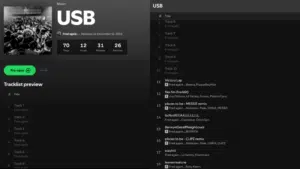Releasing music in 2025 takes more than just dropping a track and hoping for the best. How you put out your music makes a huge difference in how it’s received, how the algorithms treat it, and even how fans connect with you. The big mysterious question is: what strategy actually works best for you? While some artists swear by the traditional approach, others ride for the “waterfall” method, and many drop singles back to back with no bigger plan in mind. The thing is, each of these has its own perks and downfalls. In this post, we’ll break down three popular release strategies so you can figure out which makes the most sense for you and your goals. Here’s the rundown…
Waterfall vs. Traditional vs. Singles: Which Strategy is Right For You?
The Traditional Album Rollout
This is the tried-and-true method most people think of when they picture releasing music: dropping a couple of singles to build hype, teasing the project along the way, and then releasing the full album or EP. It’s a slow burn, but with a big payoff at the end.
Why does this work? Traditional rollouts are great for telling a bigger story. If your project has a theme or concept, this strategy gives you space to build anticipation and really let fans buy into the journey. It also creates a big “moment” when the full project drops, which can be a powerful way to grab press attention, land playlist placements, or lock in tours.
What’s the catch? It takes patience… and a lot of planning. If you don’t already have an engaged fanbase, it’s easy for momentum to dip in between singles. Not only that, but in today’s streaming world, algorithms tend to favor more frequent drops, so traditional rollouts can sometimes feel like you’re swimming against the current.
All in all, if you already have a solid fanbase, a cohesive vision, a bigger picture you want to present, or if you’re looking to make a statement with your music rather than just feed the algorithm, this may be the strategy for you.
💡 If you’re ready to try it out, try this:
- Think about structuring your rollout around two to four singles before the full project.
- Start with your strongest track as the lead single, then use the following songs to keep fans engaged while slowly revealing the bigger picture.
- Visuals, behind-the-scenes content, and live performances can help fill the gaps between singles so interest doesn’t fade.
- Timing is everything here, so spacing releases a few weeks apart keeps the momentum going and builds that excitement for the final drop.
The Waterfall Strategy
The waterfall strategy essentially flips the traditional approach. Instead of building up to a full project, you release songs one by one, with each new track adding to a growing album, EP, or playlist. The idea is to keep momentum going consistently, letting fans and algorithms discover your music over time rather than all at once.
Why does this work? Waterfall releases are great for building traction and staying on listeners’ radars. Each new track can get its own spotlight, and if you plan it right, the cumulative effect is like a rising wave; streams, playlist placements, and fan engagement grow with every drop. It’s a strategy that leans heavily into the streaming algorithms and keeps your music “active” across platforms.
A great example of this strategy is Fred again..’s USB002 project, which began in September 2025. With the tagline ’10 weeks, 10 songs, 10 cities,’ he has been releasing a new track each week and performing secret pop-up shows in various cities. The full project is set to be completed on December 12, 2025, keeping fans engaged and the momentum high throughout the rollout.
What’s the catch? It definitely requires a lot of planning and discipline to maintain the schedule. If you miss a beat, the momentum can stall, and some fans may lose track of the bigger picture. Realistically, this approach works best if you’re able to create content consistently, i.e., cover art, social posts, videos, or other visuals, to make each release feel like an event.
If you want to stay in front of listeners, gradually build a bigger project, or maximize streaming potential with a more frequent release schedule, the waterfall method can be a strong option.
💡 If you’re ready to try it out, try this:
- Plan a sequence of releases ahead of time, ideally spacing songs every 2-4 weeks.
- Treat each track like its own mini-release. Share visuals, clips, or behind-the-scenes content with each drop.
- Keep the bigger picture in mind. Even though songs come out individually, think about how they connect to the overall project/vibe.
- Encourage fans to follow along by creating a playlist that grows with every release, so they can see the “waterfall” build up over time.
The Singles-Only Strategy
Dropping singles one at a time without tying them to a larger project is a strategy that’s become super popular in the streaming era. Instead of building up to an album or EP, you just release individual tracks consistently, letting each song shine on its own.
Why does this work? Singles-only strategies give artists maximum flexibility. You can experiment with different sounds, test the waters with new genres, or respond quickly to trends. Each song can get its own push on social media and streaming platforms, and it helps keep your name in listeners’ feeds regularly. This approach works especially well for emerging artists trying to grow their audience or genre-fluid artists who want to explore different styles without committing to a full project.
What’s the catch? While singles can generate regular engagement, it tends to be harder to create a cohesive story or narrative with your music. Without a bigger project to tie everything together, it can also be easy for songs to get lost in the streaming shuffle. To ease this, you’d just need a plan to keep each release visible, whether that’s social content, playlist pitching, or collaborations to expand reach.
If your goal is to stay agile, experiment with your sound, or keep your audience consistently engaged without the pressure of a full project, the singles-only strategy isn’t a bad idea.
💡 If you’re ready to try it out, try this:
- Plan a release schedule for singles, keeping a steady pace to stay visible on streaming platforms.
- Treat each single like a mini-event with social posts, visuals, or even short videos to give fans something to engage with.
- Test different sounds, features, or collaborations to see what resonates most with your audience.
- Track performance and adjust your strategy based on what’s working, then keep the momentum going with the next drop.
——
📚 🧠 Feed yo’ brain…
How To Create a Social Media Content Calendar for Musicians
How Proper Metadata Improves Your Music’s Chance Of Success
Best Practices for Maximum Release Potential as a Symphonic Client
How To Make Money On TikTok as an Independent Musician (Updated for 2025)
——
How to Choose the Right Strategy for You
Now that you’ve got an idea of the differences between each of these strategies, you can start to think about where you fit in. Forget just following trends for the sake of following trends; it’s about what actually fits your goals, your audience, and your workflow. Here’s a simple way to think about it:
- Traditional Album Rollout: If you have a cohesive project, a story to tell, or a strong existing fanbase, this is your move. It’s perfect for creating big moments and grabbing press attention, but it requires patience and careful planning.
- Waterfall Strategy: If you want to stay in front of listeners consistently and maximize streaming engagement, a waterfall approach might be best. It works well if you can keep content flowing regularly and want to build momentum gradually over time.
- Singles-Only Strategy: If flexibility and experimentation are your priorities, dropping singles one at a time gives you freedom to test sounds, collaborate, and keep your audience engaged without committing to a larger project.
Think about your audience size, your content creation capacity, and how you want fans to experience your music. Sometimes, the best approach is a hybrid, like starting with singles to build momentum, then dropping a full project once interest is higher.
It may help to create a simple pros-and-cons list for your project and goals. List each release strategy and note the benefits and challenges for your specific situation. For example, check your analytics for things like:
🎧 Spotify for Artists/Apple Music for Artists: Check your monthly listeners, follower growth, and which songs are holding listener attention.
📊 Engagement metrics on social media: See which types of posts, clips, or teasers get the most interaction. These can signal whether your audience responds better to singles or larger project builds.
🎶 Playlist placements: Look at which songs are being added to playlists and how often. If single tracks are consistently gaining traction, a singles-only or waterfall strategy could make sense.
📍 Fan location and demographics: If your listeners are concentrated in a few key regions, you might plan timed releases or tours around that audience.
To wrap things up…
No matter which approach you choose, think of each release as an opportunity to experiment, connect with fans, and learn what works for you. Don’t be afraid to pivot if something isn’t landing the way you hoped. Don’t think of it as a failure, only a redirection! Focus on building habits and systems that keep your music visible, your audience engaged, and your creativity flowing. The more intentional you are, the more your releases can become stepping stones toward long-term growth, not just a shot in the dark.
Before you go… keep this in mind: While pre-release hype is important for generating initial streams and attention, maintaining that momentum after release day is what turns a single drop into long-term growth. Post-release content is what really keeps your track visible, engages your fans, and extends its reach across platforms. // If you’re ready to keep the energy alive far beyond release day, check out “Post-Release Strategies to Maximize Your Track’s Momentum“.
Good luck!




